| Noni fruit juice and
juice products are processed and prepared in Hawaii by a variety
of methods. For example, noni juice may be fermented
versus unfermented, or fresh-squeezed
versus drip-extracted. The “traditional”
juice is both drip-extracted and fermented/aged for at least
two months. The “non-traditional” method of juice
extraction is by pressing or squeezing the juice from ripe fruits.
Noni juices may be amended with other additives or diluted,
or bottled in its pure state. It may be bottled with or without
pasteurization. In this section, the essentials of commercial
and home noni juice processing in Hawaii are discussed and illustrated. |
|
TRADITIONAL
NONI JUICE:
Drip-extracted, fermented & aged, unadulterated |
1) Ripe
noni fruits arrive at a juicing facility (“Mahalo” to the nice
folks at bigislandnoni.com for a tour of their noni facility
near Kalapana on the Big Island of Hawaii).
Freshly picked, ripening noni fruits arrive at the juice processing
facility in a variety of containers. The harvested noni fruits
are mainly whitish in color with tinges of green. |
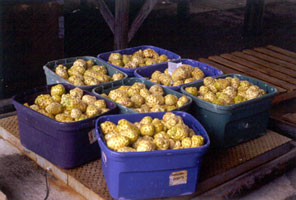 |
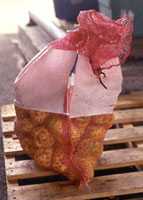 |
| LEFT:
Noni fruits are being weighed in tubs. RIGHT:
An onion bag full of freshly picked, nearly ripe noni fruits.
Green or unripe yellow noni fruits are very hard-skinned and
durable, and therefore resistant to superficial damage and bruising
during shipping an handling. They require no special handling.
Noni fruits at this stage of development will ripen overnight
or in a few days at room temperature and can be processed for
juice immediately thereafter. |
| 2) Noni fruits are
washed and air-dried. |
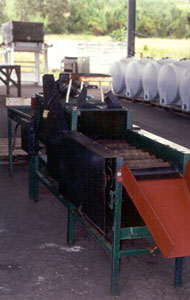
An automatic noni fruit washer, adapted for use with noni from
a vegetable operation. |

Freshly picked noni fruits after washing are allowed to air-dry
on raised tables before they are processed for juice. |
 |
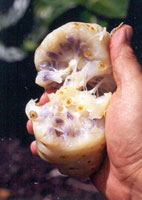 |
| LEFT:
Hard, white noni fruit just after picking (left) and soft, yellowing,
translucent, noni fruit one day after picking (right). This
translucent fruit is already starting to sweat the juice fluids
(note the moist, glistening surface of the fruit). RIGHT:
Filly ripe, translucent noni fruit with seeds. |
Fully ripe fruits contain
and release more juice than do under-ripe fruits. The most efficient
noni juice extraction by weight is obtained when ripe, soft,
translucent fruits are placed into the juice collection vessels.
When green or hard noni fruits are placed into a juice collection
vessel, the fruits release significantly less juice than soft,
ripened fruits. Furthermore, a light-colored juice product is
obtained from fully ripe, translucent fruits as opposed to the
significantly darker-colored juice that is obtained when unripe
or green fruits are placed into juice collection vessels.
3) Ripe noni fruits are placed into a juice collection vessel
for 2 months or longer. During this time, the noni juice separates
(drips) gradually from the pulp.
The juice collection and fermentation vessels should be made
of glass, stainless steel or food-grade plastic. The noni juice
collects inside the containers and ferments as it gradually
seeps and sweats from the fruits. The juice appearance is initially
an amber or golden colored liquid that gradually darkens with
age. After the collection and fermentation process is complete,
the juice is drained from spigots at the base of containers
(and filtered). Fresh air is excluded from these containers,
and contact between the juice and fresh air is minimized throughout
the process. |
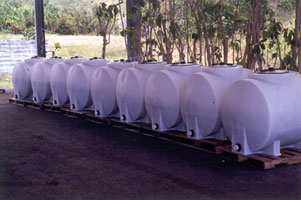 |
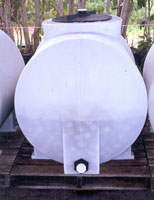 |
| LEFT:
A row of plastic noni juice collection and fermentation vessels.
RIGHT: A juice collection and fermentation
vessel, approximately _ full of noni fruits and juice. Juice
will be drained though the spigot after 2 months and bottled. |
| 4) The final noni juice
product is decanted, filtered and bottled. |
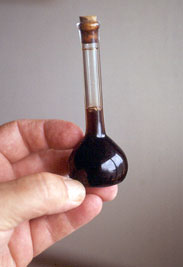
Fermented, aged noni juice is a dark brown liquid which is similar
in appearance and texture to soy sauce. The pH is relatively
low (approximately 3.5), lending a characteristically sour taste
to aged noni juice. |
Extraction efficiency
(traditional method, drip extraction). After approximately
2 months, most of the noni juice separates naturally from the
fruit pulp and may be drained from the container and filtered.
The recovery of juice by this traditional method is approximately
40%-50% of the original fruit weight. Therefore, using this
method, 100 pounds of fruit may yield about 40-50 pounds of
juice, or about 4.5 to 5.0 gallons of juice.
Leftover
pulp. After all of the noni juice is drained from the collection
and fermentation vessel, the residual pulp may be pressed to
express the remaining juice fluids. The leftover pulp and seeds
may be discarded, or they may be dehydrated and used in other
noni products.
Pasteurization. Noni juice products
in Hawaii are either pasteurized or not pasteurized. Pasteurization
does appear to alter the flavor of raw noni juice. Because fermented
noni juice usually has a low pH (approx. 3.5), pasteurization
may not always be necessary.
A variation of the
traditional, drip-extraction method produces a non-fermented,
sweeter juice. Some Hawaii noni juice producers and consumers
prefer a lighter-colored, sweeter-tasting product. If the noni
juice is not allowed to ferment in the collection vessel, the
juice will retain a relatively fruity, sweet taste, rather than
the bitter, sour taste associated with fermented noni juice.
To obtain sweeter, fruiter juice, the juice is drawn off from
the collection vessel every couple of days, and not allowed
to ferment. Rather, the juice is bottled it and refrigerated
(or frozen) immediately or until it is marketed or consumed.
Light and temperature considerations. High levels
of light exposure to the juice and high temperature during juice
collection and fermentation may cause undesirable chemical reactions
to occur in noni juice. Nonetheless, noni juice is produced
under a wide range of temperature and light conditions in Hawaii.
For example, many backyard noni juicers place a large glass
jar with noni fruits out in the direct sun for many months before
consuming the juice. However, probably the most consistent commercial
juice products are obtained where both temperature and light
are regulated during the fermentation and storage periods.
Bottling. Most noni juice producers bottle their
products in either clear glass or clear plastic bottles. Glass
is preferred to plastic for longer shelf life and quality control,
as plastics may allow some oxygen to enter the container. However,
glass is heavier and more expensive to ship than plastic. Dark
glass is rarely used by Hawaii noni juice producers. Because
light and oxygen tend to diminish a product’s shelf life,
choice of bottling container may be a significant consideration.
|
| Back to Top |
|
NON-TRADITIONAL NONI JUICE:
Fresh-squeezed, filtered & non-fermented.
|
Fresh-squeezed noni
juice has a sweeter (less acidic), fruitier flavor than aged,
fermented noni juice.
When noni fruits are ripe, the juice is separated from the pulp
and seeds using a fruit press. Up to 65% juice recovery by weight
is possible using this method of juice extraction. Home producers
of noni juice use a wide range of fruit pressing methods, from
squeezing by hand through cheesecloth, paint strainers, to more
elaborate home-made pressing devices. |
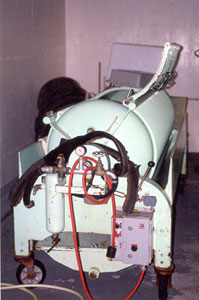
A hydraulic fruit press for making
fresh-squeezed noni juice. Ripe fruits are loaded into the press
through the top door. Juice is pressed from the pulp and bottled
immediately. |
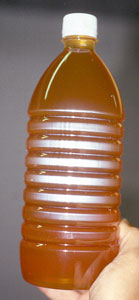
Fresh-squeezed noni juice has a golden
amber color and has significantly less sediment than fermented
noni juice collected by the traditional method. Conversely,
fermented noni juice produced by the traditional method is very
dark brown, resembling the color and texture of soy sauce. |
| Fermentation of fresh-squeezed
juice can be arrested by refrigeration or by pasteurization.
This will preserve the fruity, sweet taste of the non-fermented
juice. Or, the fresh-squeezed juice may be allowed to ferment
naturally in bottles or containers for a period of weeks or
months prior to marketing or consumption. |
| Back to Top |
|
|
AMENDED OR MIXED NONI JUICE PRODUCTS
|
| Noni juice may be mixed
with other juices of flavorings to improve the palatability
of the product (e.g., with raspberry, strawberry, or grape flavors).
Some producers choose to dilute their juice with water and sweeten
the product with the addition of sugar. |
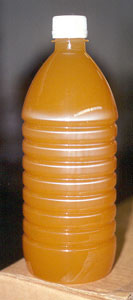
Fresh-squeezed noni juice mixed with lilikoi juice. |
| Back to Top |
|
|
RECONSTITUTED JUICE PRODUCTS
|
| In Hawaii, noni fruit
pulp may be chopped, dehydrated and powdered and used in reconstituted
noni juice products for the dietary supplement industry. These
products are standardized to approximately 0.8% noni active
polysaccharides (which is equivalent to the noni active polysaccharide
content of pure aged noni juice). |

RIGHT: Drip-extracted, fermented and aged noni
juice, showing the typical dark brown color. LEFT:
Dehydrated noni fruit powder, used in the manufacture of standardized,
re-constituted noni juice products. |
|
|
NONI JUICE POWDER
|
| Noni juice itself may be evaporated
and formed into a powder that can be used in various products,
including reconstituted juices. Noni juice powder is highly
hygroscopic (attracted to water) and must be mixed with a non-hygroscopic
carrier to enable it to retain its powdered formulation. |
| Back to Top |
|
|
TIPS FOR THE HOME NONI JUICER
|
- Hygiene. Strive for a clean, sterile environment
in the juicing area. Tools and containers may be sterilized
using hot water or simple soaps and disinfectants. Personal
hygiene of the juicing personnel is another important consideration.
- Oxygen. Try to exclude air and oxygen for the juicing
containers. The fermentation of noni juice is accomplished
by an anaerobic process (does not require oxygen), i.e.,
by bacteria that do not explicitly require oxygen for the
fermentation process. However, do not enclose the fruits
in the collection vessel using an air-tight seal on the
vessel, because the process of fermentation leads to the
evolution and accumulation of gasses within the vessel that
may build up potentially explosive pressure if not released.
Thus, the use of some type of fermentation lock is recommended
(i.e., a device which allows the exit of fermentation gasses
from of the container while disallowing the entry of unwanted
air and airborne contaminants.
- Juice color. The color of juice may be modified
(darkened) by adding green fruits to the juice collection
vessel. If green fruits are cut up before being placed into
the juice collection vessel, the cut surfaces will quickly
oxidize and turn brown, lending a overall brown color to
the juice that drips from them. For lightest-colored juice,
juice is collected or processed immediately from ripe fruits
and not allowed to ferment (i.e., the juice is refrigerated
it or pasteurized).
- Filtering of sediment. Juice may be filtered and
clarified using silkscreen (from art supply store) or paint
strainers (from hardware store). Filters or strainers can
be sterilized in boiling water before they are used.
- Quality control. If juice appears overly cloudy
or has an unusual or foul flavor or high pH, it is probably
contaminated and should be discarded.
- Wild noni picking “kokua”. When picking
noni fruits from wild plants, use care not to damage or
break the extremely brittle branches of the noni plant.
- Containers. Avoid using plastic containers for
juice collection or storage (i.e., plastic garbage cans)
that are not food-grade plastics, as they may release undesirable
chemicals into the juice.
- pH. Obtain an inexpensive set of pH papers to monitor
the pH of your juice. Good, aged noni juice should have
a pH of 3.5 or less. If the juice pH greater than 3.5, there
is a higher probability that it may be contaminated with
undesirable organisms.
- Labeling. The major advertising claims about the
healing powers of noni have not yet been evaluated by the
Food and Drug Administration (FDA), and noni (Morinda
citrifolia) does not yet appear on the FDA’s GRAS
list, i.e., the list of foods and food additives that are
“Generally Recognized as Safe” by the FDA. Therefore,
for home bottlers of noni juice who plan to label and market
their product, it would be wise to include on the label
the following or similar disclaimer: “These statements
have not been evaluated by the FDA. This product is not
intended to diagnose, treat, cure or prevent and disease.”
- Storage. Fresh-squeezed noni juice should be refrigerated.
Aged, fermented noni juice can be stored at room temperature
indefinitely.
|

Noni fruits in glass jars in various stages of decomposition
in the back yard of a modern Hawaiian homestead. These jars
are kept in full sun |
| Back to Top |
|

